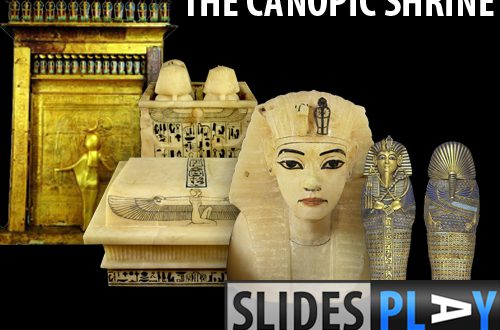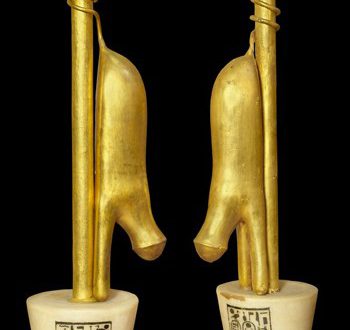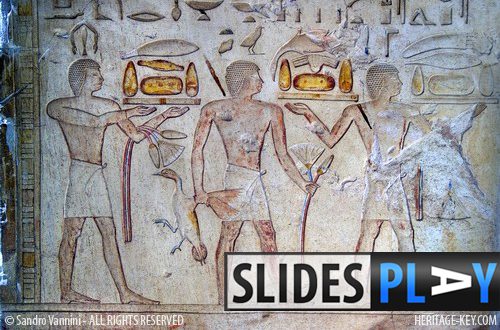 One of the best preserved and most decorated tombs in the Valley of the Kings is that of Seti I, adorned with hieroglyphics and colourful paintings on every passageway and chamber wall. In this first post on the Seti I tomb, we look at stunning photography by Sandro Vannini taken in the First Pillared Hall section of the tomb.
One of the best preserved and most decorated tombs in the Valley of the Kings is that of Seti I, adorned with hieroglyphics and colourful paintings on every passageway and chamber wall. In this first post on the Seti I tomb, we look at stunning photography by Sandro Vannini taken in the First Pillared Hall section of the tomb.
Years of archaeological excavations have damaged the tomb and as a result, it has now been closed to the public. That means the only way to enjoy the beauty of Tomb KV17 is through photography, and who better to send down there than world-class photographer Sandro Vannini! An expert in photography of some of Egypt’s most valuable treasures, such as the Golden Mask of Tutankhamun, Sandro has mastered the art of capturing ancient artefacts at their best.
Heritage Key is working with Sandro to bring his photography online for you to enjoy, and be able to see the artefacts from the comfort of your own chair. You can also find out the latest news from the excavations of Seti I’s tomb in a video with Dr. Zahi Hawass at the bottom of the page.
Sandro Vannini’s Photography
Using a vast array of professional (and expensive!) photography equipment as well as years of experience and skill, Sandro has the unique ability of being able to make a photograph come to life through his use of lighting and attention for detail. In the Tomb of Seti I, Sandro uses both a Hasselblad ELD Ixpress 528C and a Kodak DCS Pro SLR/n to capture the colourful artworks on the interior walls of the tomb. Although the tomb has now been closed, we can still admire the ancient wonder of KV17’s artworks through Sandro’s lens.
Pharaoh Seti I’s Tomb (KV17)
The tomb of Seti I was discovered by Giovanni Battista Belzoni in 1817, and is the longest (at 136m found so far) and the deepest of the royal tombs from the New Kingdom. With more detailed and refined decorations than in those tombs preceding it, this tomb dedicated to the Nineteenth Dynasty Pharaoh reflected the rich cultural and artistic merits that characterised his reign.
The above infomap shows the layout of the tomb, which has several passages and chambers. This week, we’re looking at the First Pillared Hall, which is decorated with the Osiris shrine and the Book of Gates. The hall had 14 columns onto which the image of many Gods were carved and painted, some of which were the first time they had appeared in a royal tomb.
Don’t miss out on new treasures!
This post is part of a series focussing on amazing photographs from ancient Egypt. Keep checking back as well keep adding new images by Sandro Vannini. To make sure you don’t miss out on any of the updates, simply subscribe by email to receive notifications when new images are uploaded. For the more digitally advanced, there’s also an RSS feed with updates available.
Suggest a Featured Artefact
We’re taking suggestions! which of King Tut’s treasures you would love to see highlighted on Heritage Key, and we’ll consult Sandro’s extensive archives to see what we can find for you!
Ask Sandro
We’ll be sitting down with our favourite photographer for an extended chat soon, so if you have any questions for Sandro we’ll send the answers straight to you!
The Celestial Cow
The Celestial Cow was engraved on the sarcophaus of King Tutankhamun, but in the tomb of Seti I, it was the first tomb where it was inscribed on the wall paintings. In the legend, the sun god Re was angry at mankind, and so the Celestial Cow carried him to the heavens on his back, aided by other gods.
Re-Horakhty
The tomb of Seti I was the first to hold this image of the king making offerings to the Morning Sun God Re-Horakhty, which has been repeated in all subsequent tombs built for the remainder of the New Kingdom. The detail in Sandro’s photograph shows the king wearing a nemes headdress whilst being embraced by the falcon-headed god.
The Bark of the Sun God
Taken from the Book of Gates, this scene was commonly depicted on the walls of tombs and Sandro’s fantastic photograph shows the intricate details of the version in Seti I’s tomb. At the top of the inscriptions are a series of mummies, stood with domed shrines and protected by a snake above them. They stand before the Gods who are wrapped up with their details obscured, separated by the symbol of Osiris – sheaths of wheat. The Gods stand in the Lake of Fire, where those who have been blessed will be saved, and the damned are destroyed.
Thoth and Seti I
Sandro has captured the great detail in this wall painting depicting Thoth, the patron of scribes and wisdom, with Seti I. Shown as an ibis-headed man, Thoth was an important figure as far back as Pre-dynastic times, and often appears in pyramidic texts alongside Re. Sandro chooses to detail on this image as it shows Thoth embracing Seti and welcoming him into the realm of the blessed.
The Book of Gates
The Book of Gates is depicted on the walls of Seti I’s tomb, alongside the Book of Amduat. Some Egyptologists believe the Book of Gates was offered as an alternative to Amduat as a safe passage to the Afterlife. the two books have many similarities, although there are distinct differences – for example, Amduat focuses around the concept of time, whereas Gates concentrates on space. Seti I’s sarcophagus is engraved with the text from the Book of Gates, which coincidently is more favourable to the king, giving them more prominence.
MOVIE: Dr Zahi Hawass Inside the Mysterious Tunnel in the Tomb of Seti I
Dr Hawass has spent the last two years leading an all-Egyptian team and excavating a mysterious tunnel leading from the burial chamber of King Seti I that goes deep into the Theban cliffs. Nobody has ever reached the end, and the tunnel’s purpose is as of yet unknown. Watch the video to see what Dr Hawass has to say about the excavations, and what he thinks may lay there.
You can see the transcript of the movie over on our Video Page, as well as seeing other fascinating films from the Valley of the Kings shot by Sandro in our weekly series. Additionally, you can find out more about Ancient Egypt right here at Heritage Key, as well as being able to explore KV62 – King Tutankhaman’s tomb – in 3D in our exciting virtual experience! Also be sure to keep up to date on all new postings about Sandro’s photography from Egypt by subscribing to our feed, simply by entering your email address above.




